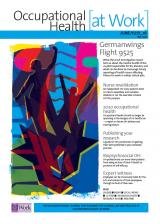June/July 2016 (vol. 13/1)
ContentsFeaturesNewsLegal
NewsResearch DigestResearch PlusCPD
Research Plus
PPE used against highly infectious diseases
This Cochrane systematic review identified nine studies assessing effectiveness of full-body personal protective equipment (PPE) in preventing infection from highly infectious diseases, such as Ebola and severe acute respiratory syndrome (SARS). Adherence to official guidelines for donning and doffing gowns and aprons reduced contamination risk compared with individually chosen methods. Interactive training (eg spoken instruction and computer simulation) was more effective than passive methods (written guidance and videos) in improving adherence to guidance. Increasing the breathability of PPE fabric did not increase contamination but improved user satisfaction. Double gloving was more effective than using single pairs of gloves. Evidence quality was very low for all the above and completely lacking on whether or not goggles gave better protection than visors, use of disinfectants while doffing, benefits of longsleeve gloves or taping parts of PPE together, or skills retention.
Cochrane Database of Systematic Reviews 2016; 4: CD011621. doi: 10.1002/14651858.CD011621.pub2
Occupational Health at Work June/July 2016 (vol. 13/1) pp40



